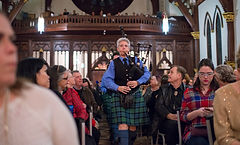


History
The reason the Celtic Cultural Center chose St. Mary's Cathedral for their event was based on part on the Irish history of St. Mary's. The Irish history of St. Mary's Cathedral dates back to her inception over 100 years ago. As Irish immigrants began to stake their claim to a new life in Texas, they gathered in Austin and developed much of Waterloo's early history. Whether it was opening a law office, working in civic jobs, or in the construction trade (bricks and limestone) the Irish took their place in Central Texas. When these early Irish immigrants gained enough political clout, they wrote to the powers that be asking for a Catholic place of worship here along the Colorado River. They also specifically asked for a strong, passionate Priest. They wrote, "if it weren't too much trouble, they would be delighted if he were Irish."
St. Mary's Cathedral actually started out as a small frontier stone Church called "St. Patrick's Church" a block or two from her current location. She soon became too small for the burgeoning community and plans were set in action to build a new Church, a bigger one, more beautiful and fitting of her status as the premier place of Worship for the capital city of Texas. By this time, the German community in Austin had expanded and wanted naming rights over the new Church, much to the dismay of her Irish founders who wanted her to carry on the name of St. Patrick. There was much consternation among her members until one brave priest declared she would be named for St. Mary, a name honored by both cultures.
The Cathedral's architect was a famed Victorian architect from Cork, Ireland named Nicolas Clayton. He created many of Galveston's finest buildings (unfortunately many were lost in the Galveston hurricanes). The bell in St. Mary's Cathedral is one of the largest in the State of Texas. It was donated by the Irish family of Michael Butler. His children's names are still etched on the side of the bell. At one of our first concerts, we were honored to have the Butler grandchildren return to the Cathedral and ring the bell for the opening of our program. - E. D. McKaskle
Footnote: Clayton (1839-1916) was one of the first professional architects to establish a practice in Texas and is most famous for his work in Galveston between 1873 and 1900. Drawings, sketches, one set of specifications (1883-1901) for 18 projects designed by Clayton are housed at the University of Texas. Among the buildings represented in the collection are Ball High School (Galveston), Dallas Orphan Asylum, New Galveston Country Courthouse (not built), Galveston NewsBuilding, Walter Gresham residence (Galveston), Hutchings-Sealy Building (Galveston), St. Matthews Catholic Church (Monroe, La.), St. Patrick's Catholic Church (Galveston), Ursuline Convent (Dallas).





